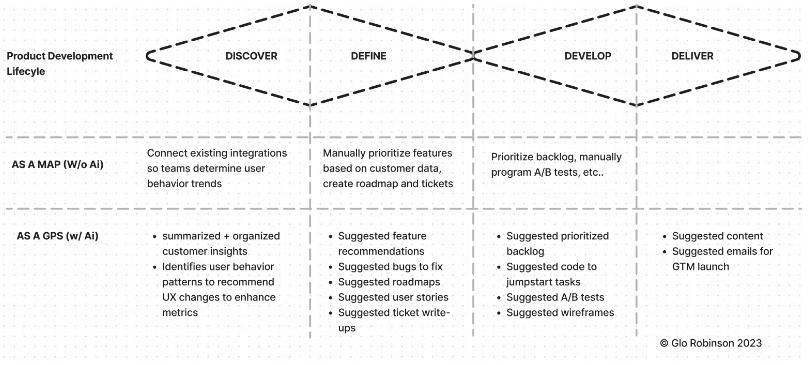Product-led growth (PLG) has become a highly discussed topic in today's competitive SaaS landscape. Under the right conditions, it's the most cost-efficient strategy to acquire users. PLG methods focus on enabling the user to experience the value of the product by themselves and to eliminate friction during use. This can lead to a significant competitive advantage over competitors that are dependent on high customer acquisition cost (CAC) models, such as a sales-led approach.
When I joined Keyhole, the company was primarily sales-driven, but this approach came with some challenges: it was costly, slow, and required extensive support to scale effectively. At the same time, we observed a promising trend — organic traffic to our blog and landing pages was growing, and more teams and individuals were reaching out to explore our product.
So we decided to conduct multiple product growth experiments with our small, but dedicated team. We aimed to improve activation, adoption, and conversion across our entire product line. By refining the onboarding funnel, enhancing in-product messaging, and implementing core PLG strategies, we increased annual recurring revenue (ARR) by 25% and boosted net revenue retention rates to 65-70% for most cohorts.
I want to share some lessons and takeaways from our journey. From overcoming initial hurdles to celebrating our successes, I hope my experience can provide valuable insights for anyone looking to transition to a product-led growth strategy.
Not every product or company is suited for PLG. Before we made the decision to switch, we evaluated several key factors to ensure it was the right approach for us. Here are some essential considerations to keep in mind before diving into PLG.
PLG isn’t a magic solution, it’s just a possible distribution model that relies on you having found the product-market fit. If your product is still in development and/or you don’t have your ideal customer profile identified, implementing PLG can have detrimental effects for your business.
Without a data-informed approach, the implemented growth initiatives are unlikely to be successful, because it won't be possible to measure successes, identify failures, or set KPIs. To ensure predictable outcomes, it’s necessary to test hypotheses by collecting and analyzing data. This requires user behavior to be tracked through ‘events’ such as clicks, sign-ups, purchases, and funnels to be analyzed to show the steps users take before completing a desired action. By doing so, organizations can identify drop-off points, understand user interactions, and make data-driven decisions to optimize their strategies and achieve better results.
Implementing growth initiatives demands substantial resources from your team and product infrastructure. If your product isn't designed to scale or your team isn't prepared to handle the increased demand, growth efforts can backfire.
Technical issues may arise under higher loads, leading to decreased user experience and customer churn. Additionally, initiatives may become disorganized and ineffective without a team equipped to execute and support growth strategies. Therefore, It's essential to ensure that your infrastructure is robust and scalable, and that your team has the necessary skills and processes in place. When both of these considerations are covered, you’re in a good position to support and sustain growth effectively.
*Note: The team that built your existing product might not be the team that can transform it.
If you are developing something in a brand new space that requires extensive explanation or has specific industry terms, a sales-led approach may be the best way to start.
If your product takes significant time before delivering noticeable value or requires a complex set-up process, your self-service users would be likely to disengage before fully experiencing product value.
Let’s consider an example: your product is a customer data platform designed for large enterprises to unify customer data from different channels (CRM, GA4, Hotjar, social media etc.) to generate actionable insights. Setting up such a platform requires extensive data integration, data-mapping, configuration of custom workflows and more. Such a process usually requires significant time and technical expertise. Before the set-up process is complete, the user doesn’t experience value. In such cases, it’s important that the users fully understand and leverage the product's capabilities. Therefore, a sales-assisted approach with guided onboarding and personalized support is likely to be more effective in helping users to experience value by navigating them through the complexities, leading to higher satisfaction and retention rates.
It takes time to see the fruits of your labor, especially when you change your strategy. At Keyhole, it took us about 13 months to notice a significant impact on retention and revenue from our growth experiments.
Product-led growth focuses on solving end-users' problems with solutions with less complexity and at a lower initial cost than comprehensive enterprise-wide offerings.
Consequently, the average contract value (ACV) captured through PLG is usually lower than that of traditional sales-led growth. Although PLG offers a higher potential for ACV expansion through continuous usage, it takes time to conduct experiments and build growth loops for different cohorts of users that bring tangible effects on metrics.
It’s important to analyze the entire funnel and prioritize the areas where the most drop-offs occur. Depending on the experiment, the results may take anywhere from a couple of weeks to several months or quarters.
During our switch to PLG , we prioritized improving Acquisition and visitor-to-trial conversion. One of the experiments that was implemented was a "Sign Up with Google" option aiming at simplifying our signup process. By reducing several steps to just a few clicks, we not only accelerated the signup process, but also ensured automatic email verification. For users without a Google account, we retained the option to sign up via work email.
Additionally, we removed the credit card requirement for starting a free trial, allowing users to try the product without any upfront commitment. We highlighted this on our pricing page to encourage more users to explore our product without barriers.
These simple changes increased the conversion rate from visitor to trial and decreased the Bounce Rate on registration page by reducing friction while signing up.
Before:
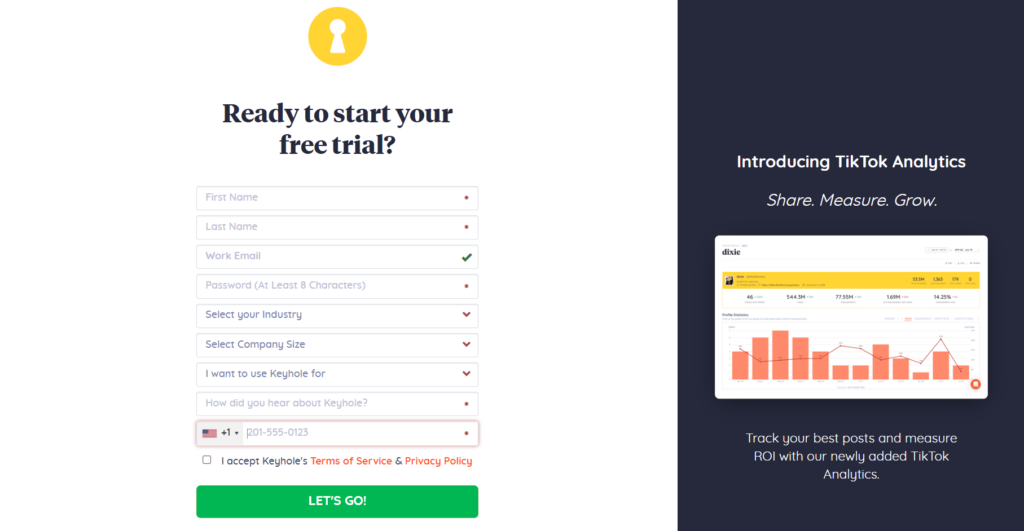
After:
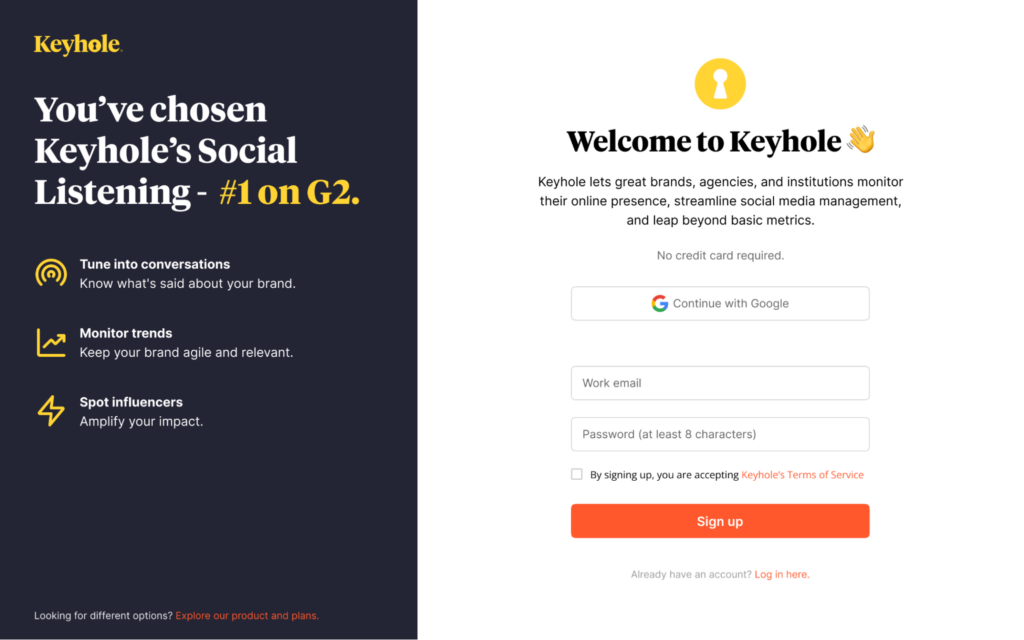
*Note: Increased acquisition does not necessarily translate to increased user activation and engagement.
After removing friction during the sign-up process, we identified another major area of drop-offs at the activation stage. We discovered that our customers needed to export at least one report and add at least two social media accounts or social listening topics within the first 48 hours to truly see the product's value.
Data showed that only 30% of new sign-ups were adding two or more profiles, meaning 70% didn't interact with the product fully. To reduce time to value and minimize additional friction, we prompted users to add a profile or social listening topic right after they chose their ‘goal’ in the product, guiding them through in-app guides:
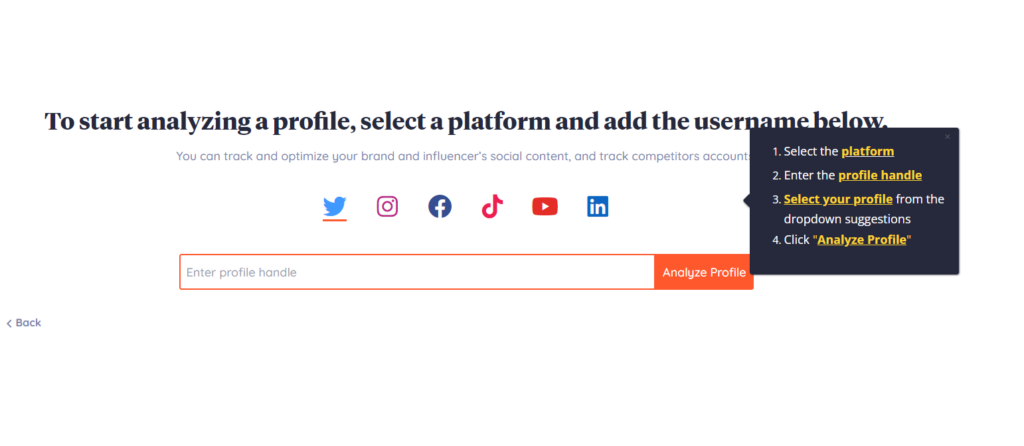
This didn’t help us reach the desired KPIs for activation. Based on Hotjar, Posthog and Mixpanel data, our users didn’t understand the full value of what Keyhole can do for them and why we need their data for that. This lack of understanding created a barrier to experiencing value, since adding data to their profiles was perceived as a chore, instead of an exciting step towards solving their problem.
To address this, we ran an experiment to explore how users reacted when landing in the product without any of their own data. Would they be more curious to add their data after seeing what they'd be able to do with it, or would it increase confusion and friction?
We decided to implement a main page/dashboard that would give users a snapshot of the product and the use cases they chose, using demo data (demo campaigns, demo profile comparisons, etc.). This dashboard also provided a quick summary of the account's metrics and limits, along with clear calls to action.
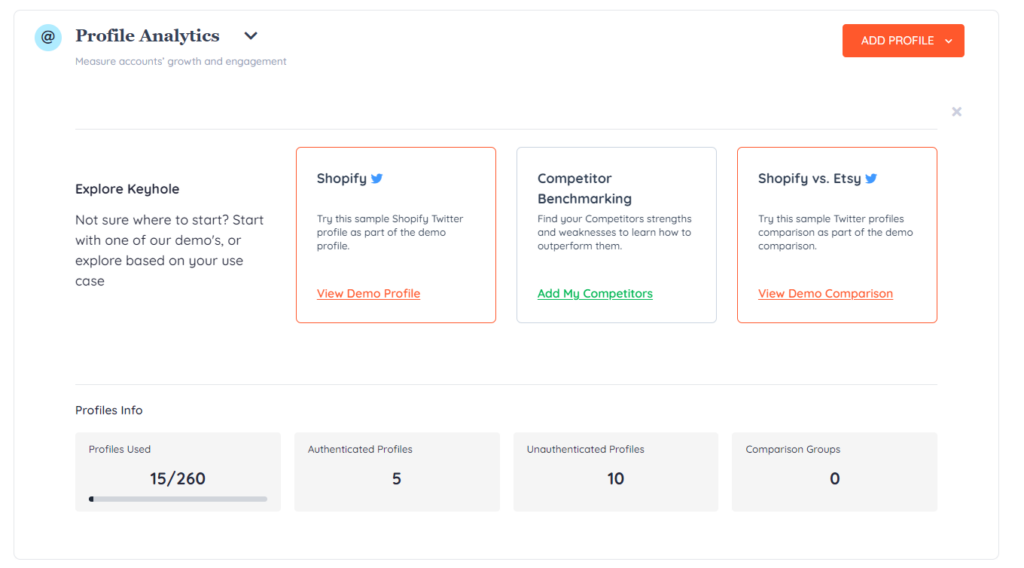
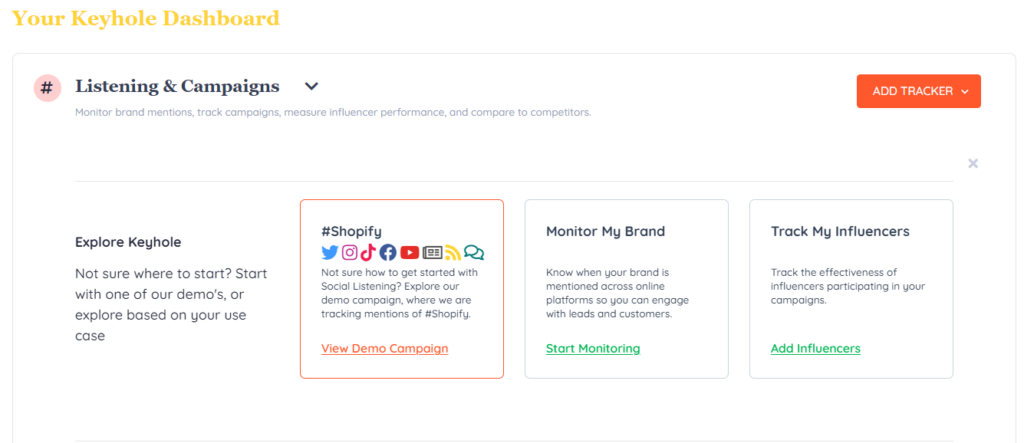
This redesigned journey and the inclusion of demo data gave users an experience of how easy it was to add a profile or enter a social listening topic, and what data they would see before doing it themselves. Virtual guides combined with a main dashboard tailored to the user's goals proved highly effective, allowing us to achieve an activation rate of 45% for the majority of self-serve cohorts.
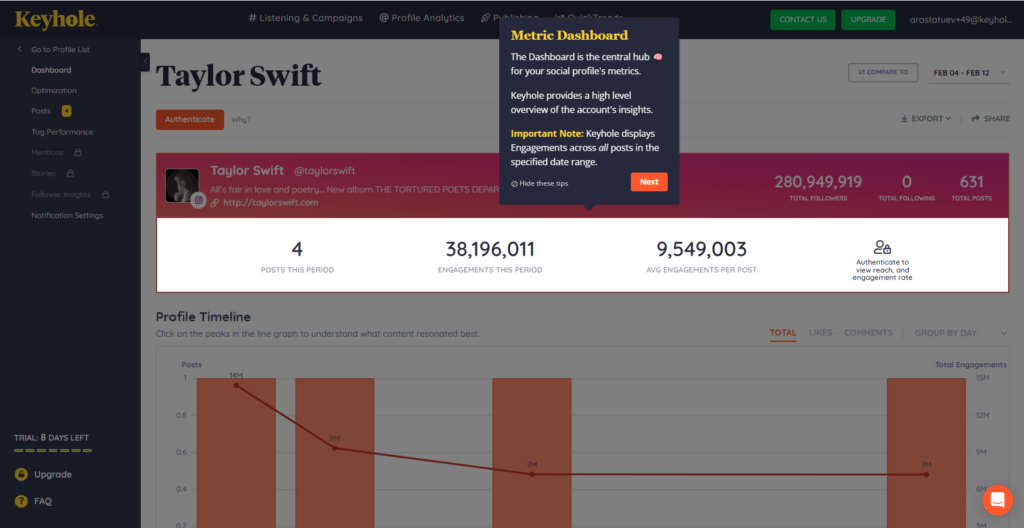
The path to activation isn't necessarily about proving all of the product's value as quickly as possible, but rather about giving users a tangible experience that they're moving toward the solution they're seeking and demonstrating that the product can solve their problem if they continue using it.
To keep users engaged and reduce overwhelm during product exploration, we continued optimizing the onboarding experience by gradually introducing product functionality tied to the user's goal selected at the beginning. For example, when a customer added several social profiles to their account, we unlocked the comparison feature in the interface so they could gain value from comparing metrics for those profiles. We highlighted this using in-app guides launched through Appcues:
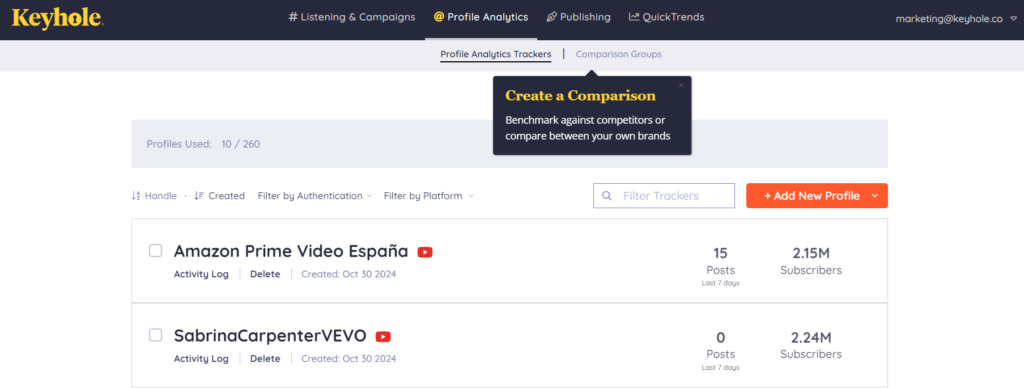
*Note: Track the completion of the in-app guides, as well as the engagement and adoption of the newly opened features between different cohorts of customers, using multiple data tools: Appcues, funnels in Mixpanel, Hotjar sessions.
Clarity and transparency should be applied to every aspect of a product in a Product-Led Growth motion — from in-app guides and product flows to ready-to-use demo accounts and, most importantly, the pricing page. The pricing page is a critical element of PLG, serving as a foundational part of the customer journey. A well-thought-out pricing page is a vital component of a go-to-market (GTM) plan and can significantly impact your product's overall growth.
At Keyhole, our monetization model was based on usage; we charged for the number of topics/profiles and the number of mentions. We began optimization of the pricing page by introducing suite plans that provided access to all Keyhole products — Social Listening, Social Media Analytics, and Publishing bundled together. We ran numerous experiments, adjusting the features and limits in each package, offering discounts for annual plans. These experiments positively impacted conversion rates, increasing the number of trials and the number of trial users who became paid customers. However, despite these gains, the experiments did not significantly impact our target KPIs for Activation, Adoption, and Retention.
What significantly affected the conversion rates was the duration of the trial. Experimentation and surveys showed that longer trial periods positively impact conversion. A 7-day free trial showed lower conversion rates because people didn't have enough time to set up and fully experience the product. We found that a 14-day trial was the optimal time for the majority of cohorts to experience and get value from Keyhole.
Another major finding was that suite plan offerings didn't show sufficient improvements (based on our product usage data). Higher retention was achieved by self-serve cohorts of customers subscribed to individual products, rather than bundled suites.
Before:
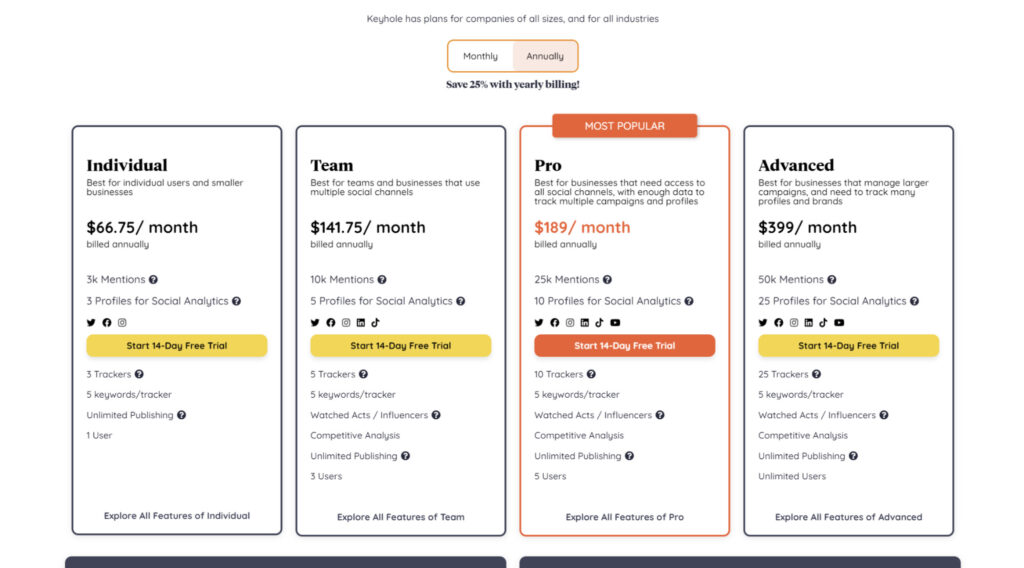
After:

That's why we switched to showcasing multi-products via tabs—social listening, social media analytics, etc.—all leading to different pricing pages. Dividing Keyhole products into modules was successful in terms of revenue retention, activation, and adoption.
*Note: To achieve proper conversion rates for multi-product offerings, it required a lot of work to drive traffic and exposure to those other products and tabs. Consider using SEO, cross-linking, or product integration.*
To drive awareness, we included cross-linking within the product:
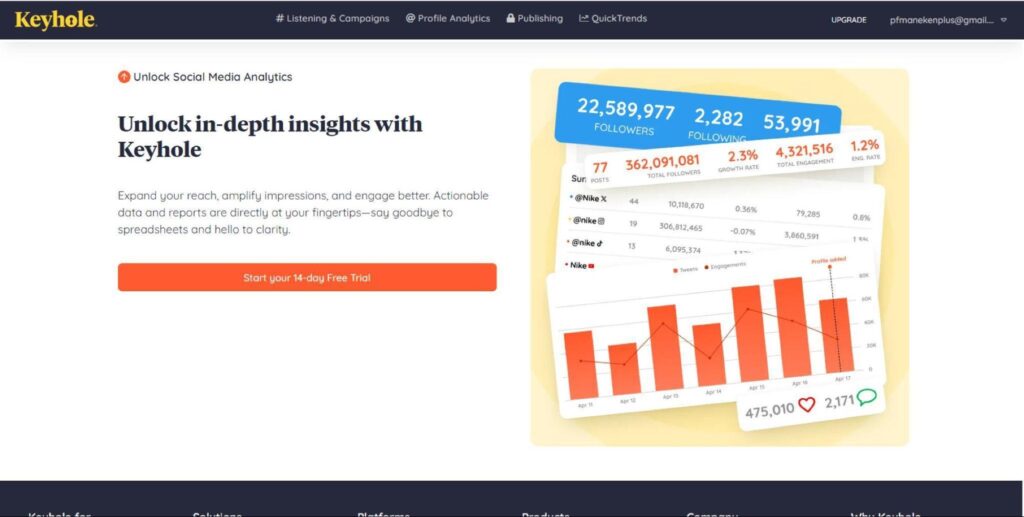
Some of the key learnings on pricing & monetization:
One of the key mistakes before implementing the product-led growth motion is thinking that implementing it is a substitute for sales. However, self-serve usage serves as the basis for promoting enterprise-level upgrades and expansions. Product-led sales is the motion that starts with users finding value in the product, then the sales team reaching out to the right accounts to educate them that there might be a better product tier for them. A good signal for PLS is when customers organically ask for an enterprise offering. Pay attention to customers reaching out through support channels, customer interviews, social media inboxes, or even direct emails, expressing a desire to purchase beyond the scope of your self-serve limits.
As we became confident about our PLG motion, we continued to strengthen our growth by enabling product-led sales. This demanded understanding what product behavior correlated with an upgrade. We hypothesized that customers on the higher tier plans who buy additional data when they hit limits and invite new team members are more likely to upgrade to Enterprise plans. Our sales team reached out to these accounts, resulting in a 10% conversion rate to higher-cost Enterprise tiers. Without sales assistance in place, it's likely that those accounts would have remained on the lower tiered self-service plans.
The transition to Product-Led Growth (PLG) is not just a shift in strategy—it’s a long-term commitment to reshaping how value is delivered, experienced, and expanded upon by users.
Achieving sustained growth through PLG requires ongoing experiments and improvements, as well as analysis across the entire funnel. From acquisition to activation, retention, and expansion, each stage must be optimized to align with customer needs and behaviors. Identifying bottlenecks, refining onboarding processes, and continuously iterating on product experiences are essential to unlocking PLG’s full potential.
It’s also crucial to recognize that PLG complements rather than replaces traditional sales functions. The synergy between self-serve models and Product-Led Sales ensures that organizations can scale efficiently while maintaining a personalized approach for high-value accounts.
Ultimately, success in PLG lies in the ability to iterate, analyze, and adapt. For companies willing to invest in this transformation, the potential rewards—enhanced customer satisfaction, lower acquisition costs, and scalable growth—are well worth the effort.




